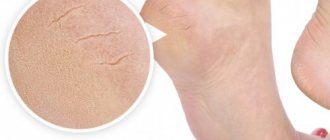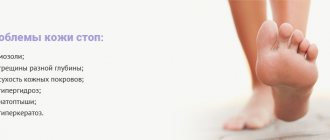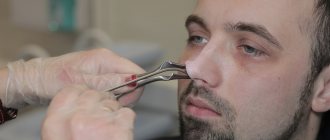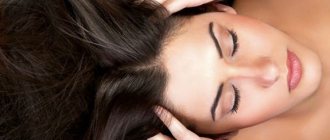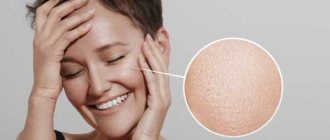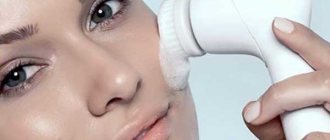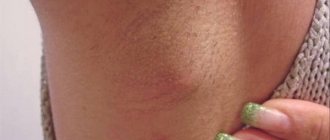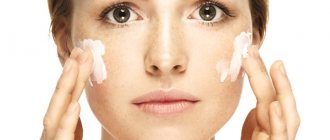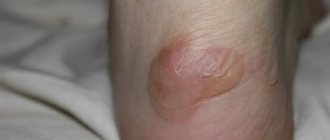Hyperkeratosis is a thickening of the outer layer of the skin. It is formed in response to skin injury as a protective reaction or when the process of epidermal cell division is disrupted against the background of certain skin diseases. The rough layer consists of keratin protein, which has rigidity and high strength.
This protein protects underlying cells from damage. When there is inflammation, irritation or mechanical pressure on certain areas, the production of keratin in them increases.
Causes of rough skin on feet
Rough and dry skin on the heels is in most cases a cosmetic problem that develops as a result of poor foot care or wearing poor-quality tight shoes. Pathological conditions develop in the following diseases:
- diabetes mellitus;
- lack of vitamins;
- dermatoses of an allergic nature;
- fungal infections of the skin of the feet;
- psoriasis;
- hormonal disorders in women during menopause.
To achieve successful results from foot care, it is necessary to eliminate the likelihood of painful skin conditions. By contacting a dermatologist, a histological examination of the rough skin will be performed.
If a pathology is detected, the doctor will identify the cause and prescribe treatment. While adhering to the doctor’s recommendations, you also need to take careful care of your feet. Without appropriate therapy, rough skin due to diseases will reappear.
If ugly skin on your heels is the result of a careless attitude towards yourself, cleansing procedures will quickly give a good effect. To do this, it is not necessary to go to specialized salons; careful care at home is enough.
Why does it happen?
Hyperkeratosis is provoked by chronic inflammatory processes on the skin, infections, ultraviolet radiation, and exposure to aggressive chemicals. If the thickening has formed without prior irritation or injury, then it is probably caused by hereditary diseases.
Under the influence of external factors, and not internal diseases, hyperkeratosis most often affects the feet.
This is facilitated by:
- improperly selected shoes (tight, chafing, inappropriate in size, with heels, made of artificial materials);
- being overweight or tall, creating a lot of pressure on the foot;
- foot deformities (flat feet, club feet), gait disturbances;
- diabetes mellitus with loss of pain, tactile sensitivity of the lower extremities, impaired nutrition of foot tissues;
- fungal infection;
- deficiency of vitamins, minerals;
- dry skin;
- injuries;
- standing for long periods of time during the day.
A rather unpleasant, painful condition is hyperkeratosis on the heels. It leads to disruption of the integrity of the skin, the formation of cracks, and limits physical activity and ability to work.
On the skin of the hands, the cause of hyperkeratosis is often sports training (exercises on the horizontal bar, uneven bars, lifting weights, playing tennis, badminton), playing musical instruments (guitar). And also work without protective gloves in the garden, features of the profession (carpenter, painter, mechanic).
Method number 1: hydrogen peroxide
Hydrogen peroxide is an affordable, inexpensive product that can be sold at any pharmacy without a doctor's prescription. It is mainly used to disinfect damaged skin. Antiseptic and exfoliating properties in combination give excellent results when cleaning the skin of the feet.
For a cosmetic procedure, it is necessary to prepare a special solution, which includes 5 tbsp. spoons of 3% hydrogen peroxide and 2 liters of hot water. For ease of use, you can choose rubbing or foot baths.
In any case, before the procedure, it is advisable to steam dry skin on the heels to achieve maximum effect. For rubbing, you can take a cotton pad or cotton cloth and, moisten it in a weak solution of hydrogen peroxide, clean the entire skin of the feet on both legs.
For baths with peroxide, you need to pour the resulting mixture into a clean bowl and place your feet there for 10 minutes. At the end, the skin of the feet is cleaned with a pumice stone or a file, and then lubricated with a rich nourishing cream.
The number of procedures will depend on the condition of the feet; usually the full course can take up to one and a half months. Once every 3 days is the optimal frequency to achieve good results; more intensive use will only dry out the skin.
It is recommended to carry out foot baths in the evening before bed, so that the skin of the feet is nourished and softened at rest for several hours.
Having achieved smooth skin on the feet, the ideal condition must be maintained regularly. The skin of the feet is subject to constant pressure and friction while walking under the weight of its own weight, so it is more vulnerable than other areas of the body.
Hydrogen peroxide will become an indispensable assistant in the fight for healthy heels.
Method number 2: Epsom salt
Epsom salts are great for removing rough skin on your heels. Bitter salt can be purchased at a pharmacy; its other name is magnesium sulfate. A unique chemical compound of sulfur and magnesium gives the skin a radiant appearance and nails a strong structure.
Epsom salt, interacting with the skin of the feet, cleanses, softens and has an antibacterial effect.
In addition to its cosmetic benefits, magnesium sulfate relieves swelling and fatigue after a long day on your feet. Sulfur with magnesium is effectively used to combat unpleasant foot odor.
Cleansing treatments for dry heels are carried out in the form of warm evening baths or Epsom salt crystals are used as a scrub. A handful of bitter salt is rubbed into the surface of rough heels for several minutes into pre-steamed skin. After the procedure, the skin is washed with warm water and generously lubricated with nourishing cream.
Cleaning rough heels with a salt solution at home is easy and pleasant. Algorithm of actions:
- Add a pinch of Epsom salt to hot, clean water and stir until completely dissolved.
- Place your feet in the solution and steam your heels for half an hour, keeping the mixture hot.
- After finishing, remove the thickened skin mechanically with a pumice stone or brush.
- We wash our feet with fresh water and dry them with a clean towel.
- Lubricate the skin of the feet with cream. To enhance the nutritional effect, you can add 3 drops of an oil solution of vitamins A and E to the cream.
In just a few days, a good result will be noticeable. The course is completed when the desired result is achieved, on average it lasts from 1 to 2 months.
Method No. 3: onions
How to clean rough skin using onions? There are onions in every home. Not everyone knows that it can be used not only for cooking, but also for cosmetic procedures.
Fresh onions are a source of calcium, fluoride, zinc, magnesium, as well as essential oils. The high content of these elements makes ordinary onions a bactericidal agent that improves the condition of the skin epithelium and has a cleansing effect.
When applied topically, onion regulates the activity of sweat glands and eliminates unpleasant odor.
To remove rough and dry skin on the heels, cut a large onion in half and place it on top. Then, on top of the onion, you can wrap your feet with cling film and put on socks made from natural materials.
It is recommended to keep the compress for 90 minutes, while your legs should be in a lowered state. After the procedure, mechanical cleaning and nourishing of the skin with cream is carried out.
Another method is to use chopped onions. The mushy mass is applied to gauze folded in several layers. The bandage is applied to the heels; the time of contact with the bow should be no more than 30 minutes.
Onions, as a means to remove rough skin, are suitable for everyone. Try not to overdo it and perform manipulations no more than once every 3 days.
Daily use can lead to inflammatory processes as a result of irritation of the sweat glands. For the fastest effect, try to choose shoes made from natural materials that can allow air to pass through.
Calcium and vitamin D
Consuming enough calcium and vitamin D is important for maintaining strong bones.
Vitamin D helps the body absorb calcium. If you don't get enough of these vitamins, over time your bones become thin and brittle (osteoporosis).
vitamin D. Also, a lack of the necessary elements can cause muscle spasms, cramps, discomfort and pain in the feet.2
Besides being good for your bones, calcium and vitamin D are also good for your skin.
Calcium in the epidermis (outer layer of skin) helps the body determine how quickly new skin cells are created to replace old ones. Thin, dry, and hard skin may appear on the legs if there is a lack of calcium in the body.3
If you are still faced with the problem of rough skin on your feet, then try making softening foot baths. After the procedure, use a Scholl electric file to remove rough skin and calluses. Don't forget to also apply cream to soften your feet.
Where are calcium and vitamin D found?
- Calcium is found in foods such as milk, cheese, and yogurt.4 Yogurt is often high in calcium and vitamin D. Calcium can also be found in vegetables (such as broccoli), grains, and fruits. Manufacturers add additional calcium to some products, so always check the label (for example, corn flake breakfast cereals).4
- Vitamin D is found in fish: especially salmon, tuna and sardines. You can also get calcium from egg yolk and beef liver, but in smaller quantities.4
Method #4: Baking Soda
Sodium bicarbonate has long been known for its unique skin cleansing properties. The softening effect will prepare rough skin to remove unwanted growths.
Antiseptic properties will remove pathogenic bacteria and fungi, which cause not only changes in the skin, but also an unpleasant odor. The anti-inflammatory effect will promote healing and regeneration of the skin of the feet.
How to properly clean your heels from rough skin using baking soda at home? There are several folk recipes:
- Dry mixture of soda and soap. A small amount of soap should be grated on a coarse grater. Add a teaspoon of soda to the crushed soap and apply to the skin in the heel area. Wrap in film, put on socks and leave the compress for 20 minutes, then clean your feet with pumice and lubricate with nourishing cream.
- Soda foot baths. Add a little soda to hot water and take baths for 15 minutes until the solution remains warm. After steaming, wash your feet with clean water and mechanically remove the rough skin on the heels. After softening with cream, be sure to wear warm socks.
- Soda with milk. An excellent effect can be achieved by using milk instead of water. The use of dairy products to nourish and soften the skin has been known since the ancient times of Egyptian beauties. Foot baths with milk follow the same pattern.
- Olive oil and soda: mix 15 grams of soda with 5 ml of olive oil and rub into rough skin. The abrasive properties of soda in dry form act like a scrub, and the oil softens the skin and makes the cleansing process more gentle.
Cracked heels: cosmetic defect or serious problem?
Many people, especially women, complain that cracked heels interfere with an active life, wearing nice shoes, and sometimes even the slightest heel crack can cause severe pain. This is not only a cosmetic defect, but a prerequisite for the development of serious pathology in the body. Therefore, it is very important to take timely measures and contact a specialist. In this article we talk about why cracked heels can form, what their danger is, where to start treatment, and what measures are most effective in combating cracked skin on the feet.
Why do problems with rough skin on the feet and cracked heels occur?
The skin of the plantar surface of the feet is thick, hairless and rich in sweat glands. Also, healthy skin on the heels should be elastic. A distinctive feature is that this area has the thickest surface layer of skin. In places that serve to support bones (for example, in the heel area), there is well-defined subcutaneous fatty tissue that protects the bone from external pressure.
Being subjected to constant stress, which increases significantly with foot deformities, wearing uncomfortable shoes, during active sports, i.e. in response to a mechanical effect on the skin of the feet, a response occurs in the form of increased cell division in the surface layer of the skin. Ultimately, this leads to the development of hyperkeratosis - thickening of the superficial stratum corneum. The skin of the feet becomes harder, less elastic, and its sensitivity to external influences decreases. Thus, the properties of the skin change.
What can cause cracked heels?
Frequent causes of cracked heels are fungal infections of the skin of the feet, allergic diseases, eczema, psoriasis, and various types of keratoderma. This may also be a consequence of mechanical influences: wearing tight or uncomfortable shoes, walking for a long time. If a person spends all day on his feet, they swell, blood circulation is impaired and, as a result, the condition of the skin of the soles and heel area suffers. A lack of vitamins or an excess of them can also negatively affect the appearance of the heels. Cracks in the heels can appear due to impaired metabolism, diseases of the endocrine and cardiovascular systems.
Are these troubles really that serious?
The appearance of cracks is accompanied by severe pain, which reduces the ability to work and limits the possibility of active sports. Cracks are dangerous, first of all, because they are “gates” for the penetration of pathogenic microorganisms, which can cause inflammation and lead to many undesirable consequences.
What is the correct, and most importantly, effective treatment?
Before starting treatment for cracked heels, it is necessary to find out their cause, consult with a dermatologist, and carry out the necessary laboratory tests. Treatment must be specialized, since in the presence of skin diseases, even the most thorough heel care will not give noticeable results. For example, foot fungus is treated with special antifungal drugs, which only a specialist can help you choose. If the cracks were caused by improper care or wearing bad shoes, you should try to change the conditions that contributed to the disease.
What can you recommend for caring for your feet at home?
All home treatments are effective in cases where dry skin on the heels is not associated with any disease. At home, baths of soap and soda help soften and cleanse the skin best: for two liters of hot water you need to take a tablespoon of soda and a tablespoon of soap. The duration of the procedure is 15 minutes. Immerse your feet in the bath and massage your heels a little, without making much effort.
To combat rough skin on the feet, ointments containing 15-20% urea and 5% salicylic acid are used. They moisturize the skin and soften it. To heal cracks, you can use drugs with methyluracil, vitamin B5, and antimicrobial action. To prevent cracked heels, you should also moisturize the skin with warm olive oil, massage, and use a rich cream or ointment with Vaseline.
It should be remembered that these simple tips will only help in properly caring for the skin of your heels. However, only a qualified dermatologist can determine the true causes of skin changes.
You can get full advice on the diagnosis, treatment and prevention of cracked heels from dermatologists at the Vita Medical Center. Our specialist will study each individual case and offer the most effective preventive and treatment measures.
Method number 5: natural honey
How to get rid of rough skin on your heels using honey. Honey is a natural antiseptic that combines an emollient and nourishing cosmetic to improve the condition of the skin of the face and body.
When cleansing the skin of the feet, to speed up the effect, use not pure honey, but a mixture of it with viburnum or prunes. When exposed to honey, rough keratinized layers noticeably peel off, releasing clean epithelium and eliminating inflammatory processes from the skin. Viburnum is a real storehouse of microelements that stimulate the growth of young layers of epithelial tissue.
How to easily and quickly remove rough skin from your heels using a compress:
- Crush 50 g of viburnum berries, after removing the seeds, and mix with half a glass of honey;
- Before applying, the paste should be heated in a water bath until warm;
- the mixture is applied to a bandage or natural fabric and applied to the heels;
- To obtain a compress effect, the legs are wrapped in cellophane and wrapped in a blanket for 30 minutes.
In a similar way, it is useful to use prunes instead of viburnum. A mixture of honey and prunes breaks down the thick dead skin layers of damaged skin, and acts as a chemical peel to remove rough skin on the heels. The skin begins to come off in large pieces, leaving the smooth surface of the feet free.
The advantage of this method is absolute safety and painlessness. Compresses with honey can be applied daily without harm to the feet. The duration of the course is extended until the desired effect is achieved.
Is there a solution?
When it comes to preventing calluses and rough skin, the best solution is to choose comfortable shoes.
When choosing your next pair, make sure there is space between the top of your big toe and the toe of the shoe. Also try to choose shoes in the evening - it is known that feet can get a little larger in the evening. To get rid of rough skin quickly and with minimal effort, you can use an electric file with an abrasive coating from Scholl.
This file with a rotating roller attachment allows you to remove corns and rough skin. The file has three attachments, each of which is suitable for different degrees of skin thickness, which will allow you to cope with even the most severe dry calluses.
Prevention of corns, calluses and rough skin of the feet
Having done a tremendous amount of work, you can achieve an amazing result. Smooth and healthy feet will delight and delight, but many people face the problem of rough skin appearing again and again. Having achieved the desired result, it is necessary to maintain the effect with preventive procedures.
Daily foot care allows you not to think about how to clean your heels of rough skin again. Mandatory evening dress includes:
- foot baths with medicinal herbs and essential oils;
- regular use of scrubs and fine-grained foot files;
- daily use of foot creams with vitamins A and E;
- using a personal towel to dry your feet.
Increased demands must be placed on shoes. Ideally, it will be made of natural materials and an anatomically correct last. In this case, the feet will be provided with air circulation, and the orthopedic padding will ensure proper distribution of the load on the foot when walking, eliminating the appearance of corns.
It should be added that daily work in caring for your feet will be rewarded with admiring glances from others when they see your feet.
Tags: Epsom salts, baths, honey, callus, hydrogen peroxide, baking soda, heel, onions, salt baths, feet, soles, care, ankle About the author: Andrey Stepanovich
« Previous entry

